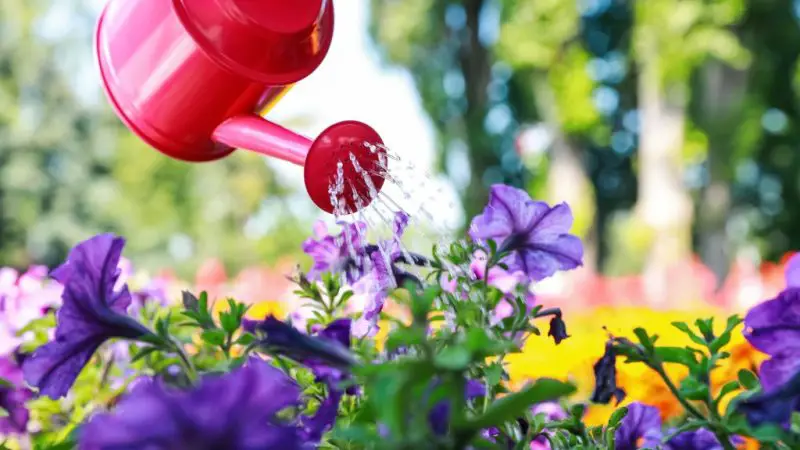Watering Petunias in Containers vs. Garden Beds
Petunias thrive in both garden beds and containers, but their watering needs differ greatly depending on where they are planted. In garden beds, petunias benefit from the natural moisture retention of the soil and can usually go longer between waterings. Watering every two to three days is often enough during mild weather, but in hotter conditions, they may need daily hydration. Deep watering is essential because it encourages roots to grow downward, helping plants become more drought-tolerant. A steady moisture level keeps petunias strong, prevents wilting, and supports continuous blooming throughout the season. If the soil surface feels dry to the touch, it’s time to water again.
Container-grown petunias, on the other hand, need more frequent watering because pots dry out faster than garden soil. The smaller the container, the quicker it loses moisture—especially in windy or sunny conditions. Petunias in hanging baskets may even require watering twice a day during extreme heat. Always water containers until you see moisture draining from the bottom to ensure all roots are evenly hydrated. Using self-watering pots or adding water-retaining crystals can help maintain consistent moisture levels and reduce stress caused by fluctuating soil conditions. Regular watering also prevents nutrient loss, keeping container petunias healthy and productive.
Whether in the ground or pots, proper drainage is vital. Standing water quickly leads to root rot and plant decline, so ensure containers have holes and garden beds drain freely. Adding mulch around bed-grown petunias helps retain soil moisture and protects roots from temperature swings. For containers, group pots together to slow evaporation and shield them from harsh afternoon sunlight. Understanding these key differences in watering frequency allows you to adapt care routines accordingly, resulting in strong, radiant petunias that bloom abundantly in any growing environment.
Seasonal Watering Guide for Petunias
Spring Watering Routine
Spring marks the beginning of the growing season for petunias, and establishing a healthy watering routine early sets the foundation for long-term success. During this season, temperatures are moderate, and evaporation is slower, meaning petunias generally need watering every two to three days. Newly planted petunias require more consistent moisture as their roots establish. Water deeply so that moisture reaches the root zone, promoting strong, downward growth. Avoid light, shallow watering, which encourages weak surface roots. Early morning watering is ideal, allowing the plants to absorb moisture before the midday sun grows strong.
As the season progresses and temperatures rise, monitor soil conditions carefully. If the top inch of soil feels dry, water immediately. Mulching around the base of in-ground petunias helps conserve soil moisture and reduces the need for frequent watering. Container-grown petunias may dry faster, so check them daily. A stable watering routine during spring ensures robust root development, lush foliage, and healthy growth that prepares your plants for the more demanding summer months ahead.
Summer Watering Routine
Summer is the most challenging time for maintaining proper hydration, as hot weather causes rapid evaporation. Petunias need frequent watering—often once a day, especially in containers or hanging baskets exposed to direct sunlight. During intense heat waves, watering twice a day may be necessary to prevent wilting. Always water in the early morning or late afternoon to minimize water loss and avoid scorching leaves. Deep watering encourages roots to grow strong and resist heat stress.
In garden beds, maintain an even moisture level by watering deeply every one to two days, depending on soil drainage. Adding a layer of mulch can help retain moisture and cool the roots. For container petunias, check the soil daily; if it feels dry just below the surface, water thoroughly until it drains from the bottom. Never allow containers to sit in standing water, as this leads to root rot. A steady and attentive summer watering schedule keeps petunias blooming profusely despite the heat.
Fall Watering Routine
As fall arrives and temperatures cool, petunias begin to slow their growth. Their water requirements decrease accordingly. Reduce watering frequency to every three or four days, allowing the soil to dry slightly between sessions. Cooler air and shorter days mean the plants lose less moisture, so overwatering becomes a greater risk. Continue watering deeply when necessary, focusing on keeping the soil evenly moist rather than soaked.
For container-grown petunias, adjust your routine by checking moisture levels before watering. If the top inch of soil remains damp, wait another day. In rainy climates, reduce watering further to prevent root diseases. Late-season watering helps strengthen the plants as they prepare for dormancy or cooler weather. If you plan to overwinter your petunias, keep them slightly moist during the transition period. Proper fall watering ensures petunias stay healthy, prolonging their bloom time and helping them finish the season with vigor and color.
How Weather and Climate Impact Petunia Watering Needs
Weather and climate play a major role in determining how much and how often petunias need water. These flowers thrive in warm, sunny conditions but can quickly become stressed when exposed to extreme heat or cold. In hot, dry climates, water evaporates from the soil much faster, causing petunias to wilt and lose vigor if not watered frequently. Under such conditions, daily watering is often necessary, especially for plants in containers or hanging baskets. On the other hand, in humid or rainy environments, the soil stays moist for longer periods, reducing the need for frequent watering. Adjusting your routine based on weather patterns prevents both overwatering and dehydration, keeping your plants balanced and healthy.
Wind is another factor that affects how quickly petunias dry out. Strong winds strip moisture from the soil and leaves, often more rapidly than sunlight alone. Gardeners in windy regions should water more often and consider using mulch to retain soil moisture. In extremely dry climates, adding organic matter like compost or peat moss helps the soil hold water longer. In cooler coastal areas, watering less frequently but deeply ensures roots receive enough moisture without becoming waterlogged. Observing daily weather conditions is the key to maintaining the right hydration balance for your plants.
Seasonal climate variations also influence watering strategies. During summer heat waves, increase watering frequency to prevent wilting, while in mild spring or autumn weather, reduce watering slightly to avoid soggy soil. Petunias grown in temperate climates generally require consistent watering throughout the season, while those in tropical regions may need shade protection to prevent excessive evaporation. By adapting your watering habits to local weather and climate conditions, you create an environment where petunias flourish. Consistency and awareness of changing conditions help ensure these blooms stay radiant, colorful, and healthy from the first planting to the final frost.
Common Watering Mistakes and How to Avoid Them
Overwatering Petunias
Overwatering is one of the most frequent mistakes gardeners make with petunias. While these plants love moisture, they cannot tolerate constantly soggy soil. When water fills all the air pockets in the soil, roots lose access to oxygen and begin to rot. The first signs of overwatering are yellowing leaves, wilting despite damp soil, and a sour smell near the roots. Over time, overwatered petunias develop soft, mushy stems and stop blooming altogether. This often happens when gardeners water too frequently without checking soil moisture first or when containers lack proper drainage holes.
To prevent overwatering, always test the soil before watering. Insert your finger about an inch deep—if it feels moist, wait another day. Use well-draining soil enriched with compost and perlite to improve airflow around the roots. In containers, empty saucers after watering to prevent standing water. Adjust your schedule based on weather conditions; water less during cool, humid periods and more during dry spells. Balanced watering ensures healthy roots, vigorous growth, and long-lasting blooms.
Underwatering Petunias
Underwatering is equally harmful and can cause petunias to lose their vigor quickly. When deprived of adequate moisture, the leaves become dry, brittle, and curled, while the flowers fade and fall prematurely. Petunias have shallow roots, making them especially sensitive to dry soil conditions. In hot or windy climates, even a short drought can cause severe stress, resulting in stunted growth and reduced flowering. Hanging baskets and small pots are particularly vulnerable because they lose moisture faster than garden beds.
To correct underwatering, water the plants deeply and slowly, allowing the soil to absorb moisture evenly. Avoid dumping large amounts of water at once, as it may run off without soaking the roots. Instead, apply small amounts gradually until the soil feels damp throughout. Mulching around in-ground petunias helps retain soil moisture and reduces evaporation. In containers, grouping plants together can create a more humid microclimate, helping them stay hydrated longer. Regularly monitoring soil moisture ensures that your petunias remain strong, colorful, and free from water stress.
Irregular Watering Schedule
An inconsistent watering schedule can cause more harm than good, even when petunias receive the right amount of water. Switching between long dry periods and sudden heavy watering shocks the plant’s root system. This stress leads to wilting, uneven growth, and flower drop. Irregular watering also weakens the roots, making them less efficient at absorbing nutrients. Inconsistent care is one of the main reasons why petunias stop blooming midseason or fail to recover from heat stress.
To establish a healthy routine, observe your plants and maintain consistent soil moisture. Water deeply and evenly at regular intervals, adjusting frequency based on the weather. During hot weeks, check the soil daily, while in cooler seasons, reduce watering slightly. Avoid guessing—let the soil’s condition guide your timing. Consistency builds stronger, more resilient roots and promotes steady blooming throughout the growing season. Once petunias receive water predictably, they flourish with lush foliage and continuous flowers from spring through autumn.
Best Time of Day to Water Petunias
The best time of day to water petunias is early in the morning, just as the sun begins to rise. Morning watering allows the plants to absorb moisture before temperatures climb and evaporation increases. It also gives leaves time to dry during the day, preventing fungal problems such as gray mold and powdery mildew. When watered in the morning, petunias stay hydrated through the hottest part of the day, helping them maintain firm stems, lush foliage, and consistent blooms. This routine also supports photosynthesis, as plants use the morning’s moisture to fuel growth and flower production. Regular early watering creates a healthy cycle that strengthens the roots and promotes long-term vigor.
If morning watering isn’t possible, the next best time is late afternoon or early evening—but only if there’s still enough daylight for the leaves to dry before nightfall. Watering too late in the evening keeps the foliage wet overnight, increasing the risk of fungal disease and root issues. During hot summer months, watering at sunset may temporarily cool the plants, but it should be done carefully to avoid standing moisture. Adjusting the timing based on weather conditions ensures your petunias receive enough hydration without excess humidity or rot.
Avoid watering in the middle of the day, especially under direct sunlight. High heat causes rapid evaporation, meaning most of the water never reaches the roots. It can also cause leaf scorch if droplets act as magnifying lenses on delicate petals. A consistent early morning watering schedule is the simplest and most effective way to keep your petunias fresh, colorful, and continuously blooming. By aligning your watering routine with the plant’s natural rhythms, you give your petunias the perfect foundation for healthy, radiant growth all season long.
How to Adjust Watering for Different Petunia Varieties
Different types of petunias have unique growth habits and water needs, so understanding each variety helps you tailor your watering routine effectively. Grandiflora petunias, known for their large and showy blooms, require more careful watering because their big flowers are delicate and prone to damage in extreme conditions. These petunias prefer evenly moist soil and slightly cooler roots. Overwatering can cause the blossoms to droop or rot, while underwatering quickly leads to wilting. Water them deeply about every two days, adjusting based on weather. Providing early morning water ensures their large blooms stay hydrated and vibrant throughout the day without becoming soggy.
Multiflora petunias, on the other hand, are hardier and better suited for warmer climates. Their smaller, more numerous blooms make them tolerant of brief dry spells. However, consistent watering still helps them produce continuous flowers. They thrive with moderate watering every one to two days during summer, depending on temperature and soil drainage. Because these petunias are dense and bushy, water should be directed toward the base to prevent the leaves from staying wet for too long. This reduces the chance of mildew and keeps airflow around the foliage healthy. Balanced watering promotes abundant blooms and prevents legginess.
Wave or spreading petunias, often used in hanging baskets and ground covers, need the most frequent watering because their wide, cascading growth causes soil to dry out faster. In containers or baskets, they may require daily watering, and during heat waves, sometimes twice a day. However, ensure excellent drainage to prevent waterlogging. For ground-grown wave petunias, deep watering two or three times a week is usually sufficient. Adjusting your watering habits based on variety ensures each type of petunia thrives in its environment, producing full, long-lasting, and brilliantly colored blooms that define a healthy and well-cared-for garden.
FAQs About Watering Petunias
How often should I water petunias in hot weather?
During hot summer days, petunias may need watering once or even twice a day, especially in containers or hanging baskets. Always check the soil before watering—if the top inch feels dry, it’s time to hydrate. Deep watering helps the roots stay strong and prevents wilting in extreme heat.
Can I water petunias at night?
Watering petunias at night is not recommended because wet leaves and soil create ideal conditions for fungal diseases. If you can’t water in the morning, do it in the late afternoon while there’s still sunlight. This gives the foliage enough time to dry before evening.
What’s the best way to water petunias in pots?
For potted petunias, water slowly until liquid drains from the bottom of the pot. This ensures the entire root system receives moisture. Avoid letting pots sit in water, as this leads to root rot. During warm months, check moisture levels daily to maintain consistent hydration.
Why are my petunias wilting even though I water regularly?
Wilting despite frequent watering usually means poor drainage or root rot from overwatering. Ensure your soil or potting mix drains well and that containers have holes at the bottom. Let the soil dry slightly before watering again to restore healthy oxygen flow to the roots.
Do petunias need less water in the fall?
Yes, as temperatures cool and sunlight decreases, petunias need less frequent watering. Water every three to four days or whenever the top inch of soil feels dry. Overwatering during cool weather can cause root rot and shorten the blooming season. Reduce watering gradually as growth slows.
Conclusion
Mastering how often to water petunias is the key to keeping them healthy, vibrant, and blooming for months. By understanding your soil, climate, and plant variety, you can create a watering routine that meets their exact needs. Deep, consistent watering builds stronger roots and prevents both drought stress and root rot. With the right balance of moisture, sunlight, and care, petunias reward you with dazzling colors and continuous blooms from spring until the first frost. A mindful watering habit not only extends their life but also transforms your garden into a living masterpiece filled with energy, fragrance, and radiant beauty.







